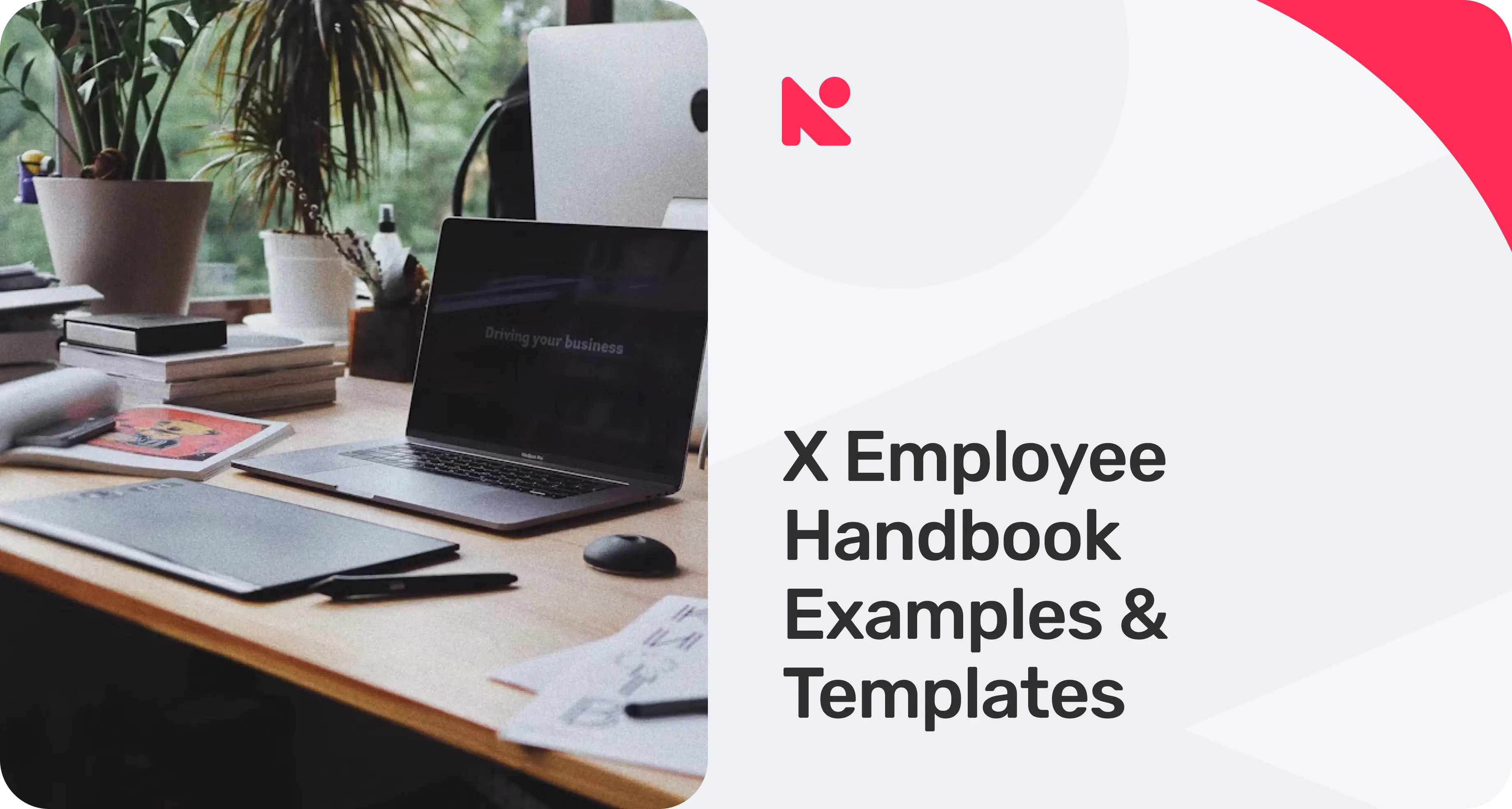HR’s Guide to Employee Handbook Examples & Templates for 2025
With instant messaging, Slack channels, and constant updates in work policies, a physical or digital handbook might seem unnecessary. Yet a clear, well-written employee handbook remains important. It sets the foundation for your company’s culture, guides new hires, and provides an easy reference for important policies.
An effective handbook is more than a stack of rules - it’s a practical, dependable guide that explains how your organisation works, protects both employees and the company, and helps people feel included.
Whether you’re a startup creating your first version or a large business refreshing an existing one, the employee handbook examples and templates below will show you how to build a modern, engaging resource for your team.

Why employee handbooks remain essential in 2025
Employee handbooks continue to be a foundational tool for businesses in 2025 because of legal, cultural, and operational shifts.
With many jurisdictions enacting new labour laws (e.g. sick leave, parental leave, anti-harassment) and remote work becoming normalised, the presence of a handbook helps ensure everyone is on the same page.
For example, in 2025, at least 14 U.S. states implemented new labour laws that employers must reflect in their handbooks. Looking at updated employee handbook examples from companies in different regions can help you see how they address these changes.
Role in onboarding, compliance, and team culture
A well-written handbook streamlines employee onboarding by helping new employees understand what the company stands for, what is expected of them, and how things are done. It reduces confusion. From a compliance view, it shows that the company takes international employment laws seriously - reducing risks of lawsuits or fines.
Culturally, it acts as a north star: the way you write the handbook (tone, examples, values) helps shape how the team behaves.
Early usage of “employee handbook examples”
Looking at existing employee handbook examples before writing your own helps you see what works: what structure, what tone, which sections are often included or left out. Early-usage or sample handbooks (from well-known companies or HR resources) serve as templates - saving you time and helping you avoid common pitfalls.

What makes a great employee handbook?
Not all employee handbook examples are equal. The difference between a handbook that sits unread and one that becomes an essential point of reference lies in clarity, structure, and how legal issues are handled. The best ones balance being user-friendly and covering critical compliance areas.
Clarity, tone-of-voice, legal compliance
- Clarity: Use simple, direct language. Avoid complex jargon and legal-speak. The goal is to make it easy for every employee to understand their rights and responsibilities, no matter their role.
- Tone of voice: Your handbook's tone should reflect your company's culture. If you're a fun, creative startup, your handbook can be conversational and vibrant. If you're a more traditional organisation, a professional, straightforward tone is more fitting. This sets the right expectations from day one.
- Legal compliance: While the tone can be friendly, the content must be legally sound. This includes covering things like equal opportunity employment, at-will employment disclaimers (where applicable), and other mandatory policies required by local, state, or national laws. For example, many handbooks in 2025 are being updated for laws like the Pregnant Workers Fairness Act (USA) and updated harassment enforcement guidance.
Structure, sections, and updates
The way your handbook is organised determines how useful it is. A clear structure helps employees quickly find what they need.
- Sections: Break the content into logical, easy-to-read sections with clear headings and a table of contents (if digital / printed). Use subheadings to divide policies further.
- Formatting: Use formatting like bold text, bullet points, maybe infographics, and numbered lists to highlight important information and make long policies easier to digest.
- Updates: A handbook is never truly finished. It needs to be a living document that you update regularly to reflect changes in policy, law, and company culture. Specify version number, last review date; schedule regular reviews (annually or more often when there are major changes).
A great reference for everyone
A great handbook serves as a guide for every stage of an employee’s journey.
- For onboarding: It's the perfect introduction for new hires, giving them a clear picture of what the company is all about.
- For existing employees: It's a quick reference for questions about benefits, time off, or remote work policies.
- As a cultural guide: It goes beyond just rules, outlining the company's mission, values, and vision.
Digital-first and accessible
In 2025, a paper binder is no longer the standard. Great handbooks are now digital-first. They’re easily accessible on mobile devices, searchable, and can be updated instantly for everyone. Consider using a tool like a company wiki, a shared drive, or a dedicated platform.
Interactive content
- Logical flow: Arrange content from most universal (welcome, mission) to most specific (policies, benefits, legal notices). This mirrors an employee’s journey from joining to day-to-day work.
- Searchable format: In digital handbooks, provide a table of contents and a search box. This helps employees quickly find “holiday policy” or “expense claim form” without scrolling.
- Cross-links: Link to your benefits portal, IT helpdesk, or learning platform directly from the relevant section so employees don’t have to hunt for them.
- Feedback option: Include a simple form or email address at the end of the handbook: “Didn’t find what you needed? Let HR know.” This helps you catch gaps early.

Key sections to include
A fantastic handbook covers both the soft stuff (culture, values) and the hard stuff (legal policies, safety). Missing one of the core sections can lead to confusion, disputes, or risk. Here are some key things to include:
Company mission, values, culture
Start by answering: Why does this company exist? What principles guide us? Employees feel more connected when they understand what you stand for. If you have a slogan or “company story,” put it here. This section sets the emotional tone and helps new hires align their actions with your goals.
A study by Paycor shows that introducing employees to culture, mission, and values helps.
Diversity, equity and inclusion
Make your commitment to DEI clear. Outline your policies, reporting mechanisms for bias or harassment, and the support programmes you offer. When new hires see how inclusion fits into the company’s purpose, they’re more likely to adopt those behaviours and feel safe speaking up.
Everyday policies and conduct
This section covers the daily rules: paid time off, remote or hybrid work, working hours, codes of conduct, anti-harassment and workplace respect. Write in plain language to reduce confusion. Explain eligibility (how many paid days off, deadlines, who qualifies for remote work) and your expectations for professional behaviour.
Benefits and well-being
Alongside policies, outline the benefits that support your employees — health insurance, retirement plans, mental-health resources, stipends, fitness reimbursements or wellness allowances. Presenting benefits in a clear, centralised place helps employees know what’s available and how to access it.
You can also explore our blog on the best employee benefits to attract remote workers in 2025 for more ideas to strengthen your benefits offering.
Safety, compliance and security
This section protects everyone. State emergency procedures, where safety equipment is, and who to contact. Include confidentiality rules, data-security policies, and mandatory legal notices such as equal-opportunity statements. You can also detail technology-use policies — acceptable use of company devices, password protocols, use of AI tools, and reporting cyber incidents.
Growth and performance management
Explain how employees can grow within your company. Outline what new hires should expect in their first 30, 60 and 90 days, required training, how performance reviews work, criteria for promotions, and how to appeal decisions. Transparency here builds trust and shows your investment in people’s careers.
To dive deeper into this topic, check out our blog on performance review & feedback examples for every role.
Communication, pay and lifecycle processes
Round off your handbook with the practicalities of day-to-day work and the full employee journey. Cover communication guidelines (email etiquette, internal chat, meeting norms, social media use), expense and travel policies, and compensation details (pay schedules, overtime eligibility, bonuses).
Also include disciplinary and grievance procedures so staff know how to raise issues, plus recognition and reward programmes and the exit process — notice periods, final pay, return of company property, and reference policy. This gives employees a clear map of how they’ll be supported from onboarding to their last day.

Employee handbook examples
These employee handbook examples help you visualise how these sections work together. They also help you tailor the handbook to your kind of organisation. Below are suggested outlines for different types of companies so you can pick what fits you best.
Tech startup example outline
Tone: Friendly, energetic, and informal with a touch of creativity. Use emojis, graphics, or a conversational tone to reflect an innovative culture.
Focus: Fast growth, flexibility, hybrid work, and innovation. Policies should emphasise autonomy, experimentation, and team collaboration.
Key sections to include:
- Welcome and company story
- Culture and values
- Flexible work arrangements
- Benefits and perks
- Tech and security policies
- Growth opportunities
Non-profit example outline
Tone: Purpose-driven, inclusive, and transparent. Show the organisation’s mission first, policies second.
Focus: Mission impact, ethical practices, donor accountability, and volunteer integration.
Key sections to include:
- Mission and impact
- Culture of service
- Ethics and compliance
- Volunteer and staff interaction
- Benefits and well-being
- Performance and development
Global / distributed team example outline
Tone: Clear, inclusive, and culturally neutral. Avoid jargon or region-specific slang.
Focus: Consistency across time zones, legal compliance in multiple jurisdictions, and inclusivity for all employees regardless of location.
Key sections to include:
- Global mission and principles
- Remote work norms
- Cross-cultural collaboration
- Local compliance
- Security and privacy
- Performance and feedback
Related: Cross-Cultural Collaboration in Remote Teams
Startup example outline (non-tech)
Tone: Energetic but grounded, practical yet personal. Show ambition but keep policies simple.
Focus: Getting the basics right while building a strong culture and clear expectations.
Key sections to include:
- Welcome and vision
- Core values
- Work hours and flexibility
- Benefits and perks
- Health and safety
- Career pathway
Global/remote organisation example outline
Tone: Professional but approachable. Consistent and easy to translate into different languages or formats.
Focus: Creating a unified experience for all employees while respecting local laws.
Key sections to include:
- Welcome message and global culture
- Communication guidelines
- Localised benefits
- Cybersecurity and data privacy
- Performance and learning
- Well-being and inclusion
Best practices for updates & maintenance
A handbook isn’t something you write once and forget. If you don’t maintain it, it can become obsolete or even dangerous (in legal terms). Having solid update practices ensures your handbook stays relevant and trusted.
Review schedule, versioning, and digital distribution
Set a regular review schedule, at least once per year, or immediately after significant legal or business changes. Tag each version with the date and version number. Use digital platforms (intranet, HR system) for distribution; a digital format allows you to update the handbook instantly and notify everyone of the changes.
Employee acknowledgement process
Ensure employees sign or digitally acknowledge that they’ve read and understood the handbook. This can be as simple as an e-signature on a PDF or a checkbox on a digital platform, and helps both in promoting understanding and protecting the company legally. Keep records of acknowledgements.
Offer multilingual versions for global teams
If you operate in more than one country, translate the handbook into the main languages of your workforce. Employees are more likely to read and understand policies when they’re written in their first language.
Use smart notifications for updates
When a policy changes, don’t rely on employees to “check back later.” Send automatic notifications via email, your HR platform, or even push alerts in your company app. A short “what’s changed” summary keeps everyone in sync.

Final note
Writing an effective employee handbook is more than copying template policies. It’s about combining clarity, legal correctness, and culture in a way that reflects who you are as a company. While these employee handbook examples and templates provide a solid starting point, the most important step is to customise them.
To stay relevant in 2025 and beyond, schedule regular reviews, include the policies that matter most, and ensure the handbook feels like part of your company’s living culture — not just a shelf document.
